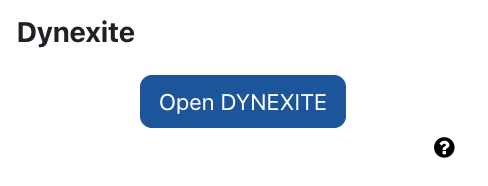Dynexite

Electronic tests are a central part of digital teaching at RWTH Aachen University. The RWTH uses the examination system Dynexite. The software is developed and maintained by the department Medien für die Lehre at the Center for Teaching and Learning Services (link only available in German) of the RWTH Aachen University. 'Medien für die Lehre' supports lecturers in the context of a full-service offer with the implementation of tasks as well as the planning and execution of your electronic exams.
If you have any questions regarding content or encounter technical problems, please contact the ePrüfungsteam.
The e-examination system Dynexite can be used not only for summative examinations but also for assignments during the semester. It can be integrated as a third-party system into course rooms in RWTHmoodle. The integration works via a block that is added to the course room. This contains a clickable button that directs students to Dynexite. There they can access the appropriate context directly without an additional login and complete their exercises.
Access to Dynexite is available via the RWTHmoodle course room. Participants of the course can access the corresponding context in Dynexite with a single click and without an additional login. If a login via RWTHmoodle is not possible, the login via the homepage of Dynexite via the RWTH Single Sign-On is an alternative option.

Content
1. Add Dynexite block
2. Give course ID to Dynexite support
3. Login via the RWTHmoodle course room (Default)
4. Alternative Login (in case of RWTHmoodle disturbances)
Please contact the Dynexite team of Medien für die Lehre at CLS before using Dynexite in your course room: epruefung@medien.rwth-aachen.de
- Switch the course room to edit mode using the "Edit mode" slider next to your name in the upper right corner.
- Select the block "Dynexite" from the drop-down menu "Add a block" above the existing blocks.
- The new block will be added automatically to the existing ones. Using the button "Open DYNEXITE" will take students directly to Dynexite without having to enter their login data once again.

2. Give course ID to Dynexite support
- Click on "Edit settings" in the center menu guide.
- You will now be taken to the Course Settings. Scroll down to the end of the section "General". Here you will find the Course ID number of your RWTHmoodle course room. The ID follows the pattern 20ws-12.123456, i.e. it is composed of a semester abbreviation and the course number from RWTHonline, separated by a hyphen.
- Enter the course ID into Dynexite. To do so, please follow this guide: https://docs.dynexite.rwth-aachen.de/manual/exercise_system
3. Login via the RWTHmoodle course room (Default)
In course rooms that use Dynexite, there is an additional block "Dynexite" among the blocks on the right side of the course room. When you click on the "Open Dynexite" link in the block, the website Dynexite with the appropriate context will open in a new tab. The login is done automatically.
4. Alternative Login (in case of RWTHmoodle disturbances)
If necessary, students can also access Dynexite independently of the course room and log in directly to the system's website.
Note
- Please use this alternative login only if there's an incident in RWTHmoodle and if you urgently need access to the system!
- The alternative login via the RWTH Single Sign-On only works if you have clicked the link to Dynexite in the appropriate course room at least once before. Otherwise Dynexite cannot establish a link to the desired course.
The alternative login is possible on the following page:
https://dynexite.rwth-aachen.de/l/login
Click here on "Anmeldung über Shibboleth" and enter your access data for the RWTH Single Sign-On in the login mask.

Further information:

